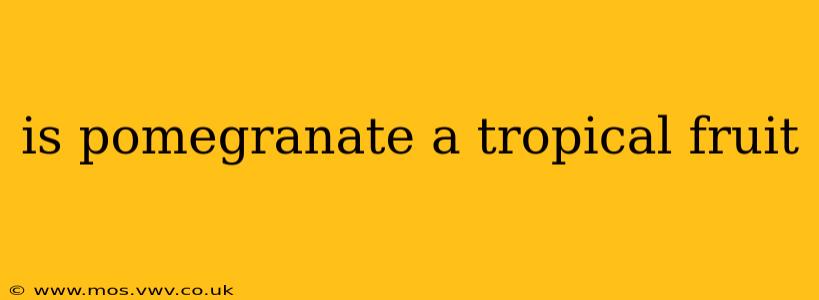The question of whether a pomegranate is a tropical fruit is a bit more nuanced than a simple yes or no. While pomegranates thrive in warm climates, classifying them solely as "tropical" isn't entirely accurate. Let's delve deeper into their growth requirements and dispel any misconceptions.
What are the characteristics of tropical fruits?
Before we label the pomegranate, it's helpful to define what constitutes a tropical fruit. Generally, tropical fruits are those that grow best in tropical and subtropical climates, characterized by consistently warm temperatures, high humidity, and abundant rainfall throughout the year. Examples include mangoes, pineapples, and bananas. They generally struggle to survive frost or prolonged periods of cold weather.
Where do pomegranates grow best?
Pomegranates are incredibly adaptable, flourishing in a wide range of climates, but they are not as heat-dependent as many truly tropical fruits. They prefer warm, sunny conditions with well-drained soil, but they can tolerate some frost, unlike many tropical fruits. This tolerance to cooler temperatures is a key differentiator. While they thrive in subtropical regions, they can also be grown successfully in warmer temperate zones.
What is the ideal climate for pomegranate cultivation?
The ideal climate for pomegranate cultivation features:
- Warm summers: Long, hot summers are crucial for fruit development and ripening.
- Mild winters: While they can tolerate some frost, extended periods of freezing temperatures can damage the tree.
- Well-drained soil: Pomegranates are susceptible to root rot, so good drainage is essential.
- Plenty of sunshine: At least six hours of direct sunlight per day are recommended.
So, is a pomegranate a tropical fruit or not?
Given their adaptability and ability to withstand some cold, pomegranates are more accurately classified as subtropical fruits. They share some characteristics with tropical fruits, such as a preference for warm climates, but their tolerance to cooler temperatures distinguishes them. They're comfortably grown in areas that are too cold for many true tropical fruits.
What are some other subtropical fruits?
Many fruits fall into the subtropical category, enjoying similar climate preferences to pomegranates. These include citrus fruits like oranges and lemons, avocados, figs, and olives. They often exhibit a remarkable ability to thrive in diverse environments, provided they meet certain fundamental temperature and soil requirements.
Are there different varieties of pomegranates?
Yes, there are numerous pomegranate varieties, each exhibiting slightly different characteristics regarding cold tolerance and growth habits. Some are better suited for warmer climates, while others demonstrate greater hardiness in cooler regions.
Can pomegranates be grown in tropical climates?
While pomegranates can be grown in tropical climates, they may not produce as abundantly as they do in subtropical regions. The consistently high humidity and lack of a distinct dry season in some tropical areas can lead to increased susceptibility to disease.
Conclusion: Pomegranate's Climate Classification
In conclusion, the pomegranate isn't a tropical fruit in the strictest sense. Its ability to tolerate cooler temperatures and thrive in subtropical regions makes it a better fit for the subtropical fruit category. While they enjoy warm weather, they aren't as dependent on consistent tropical conditions as other fruits in that category. Understanding this distinction helps in effectively cultivating these delicious and versatile fruits worldwide.
